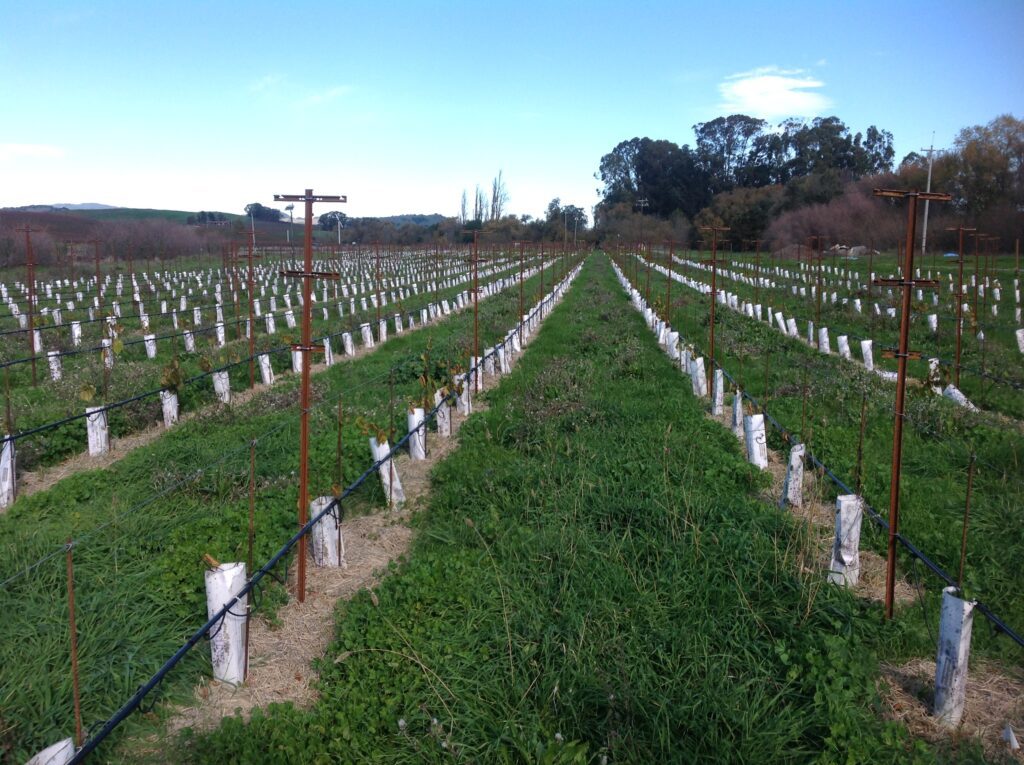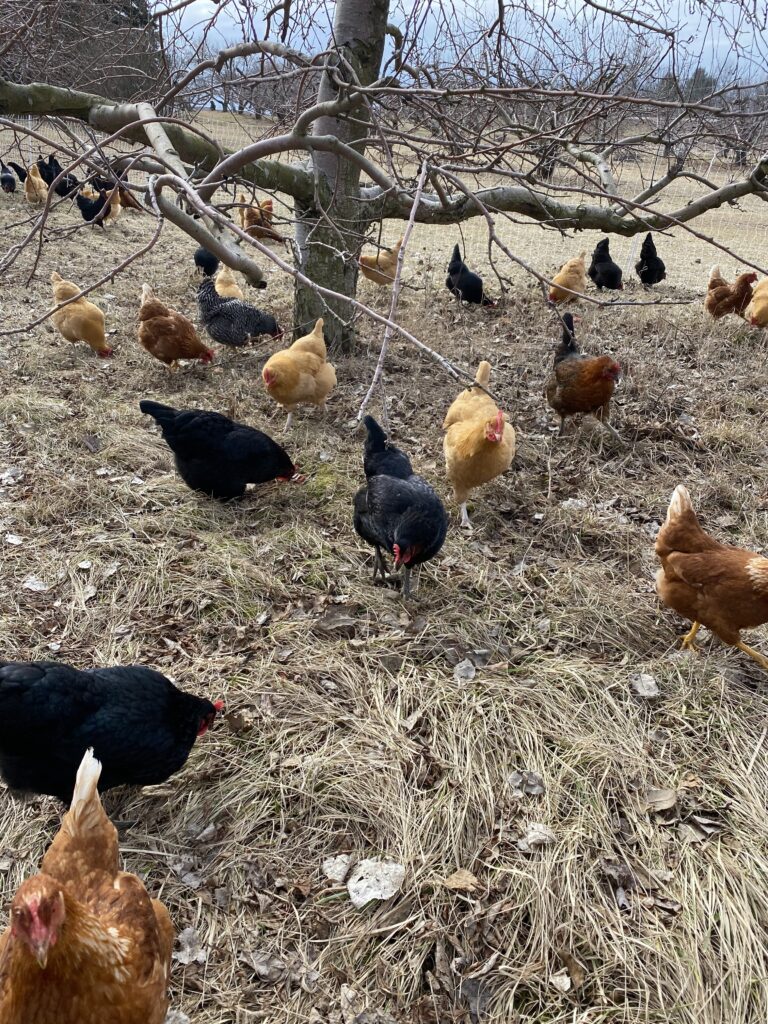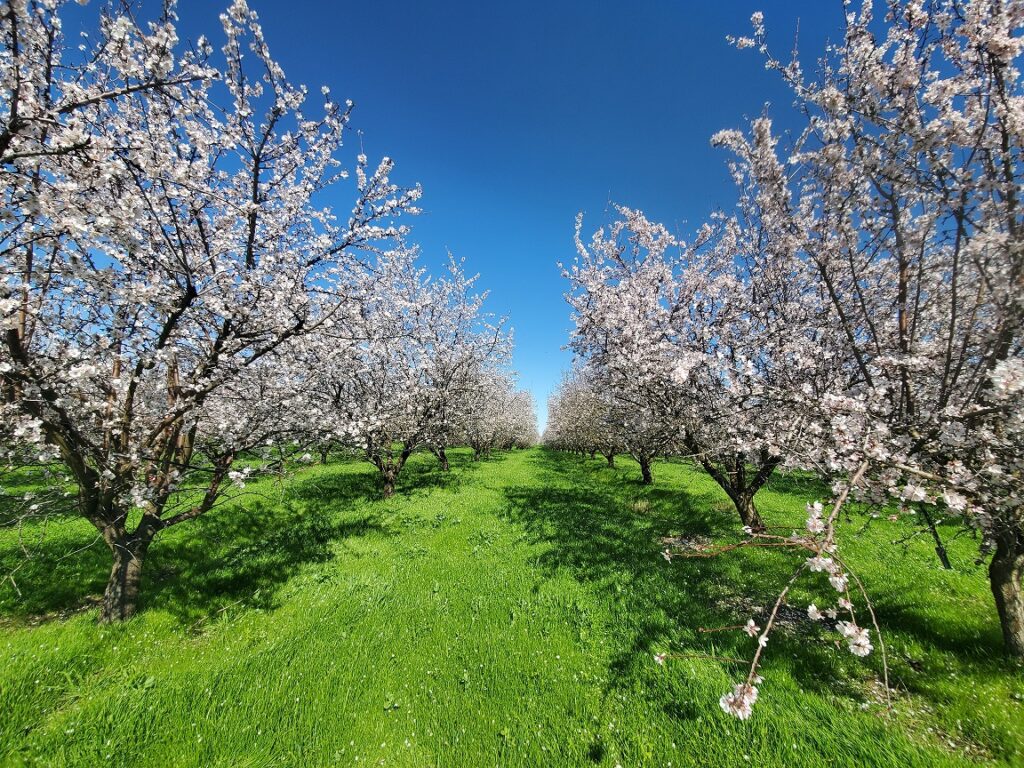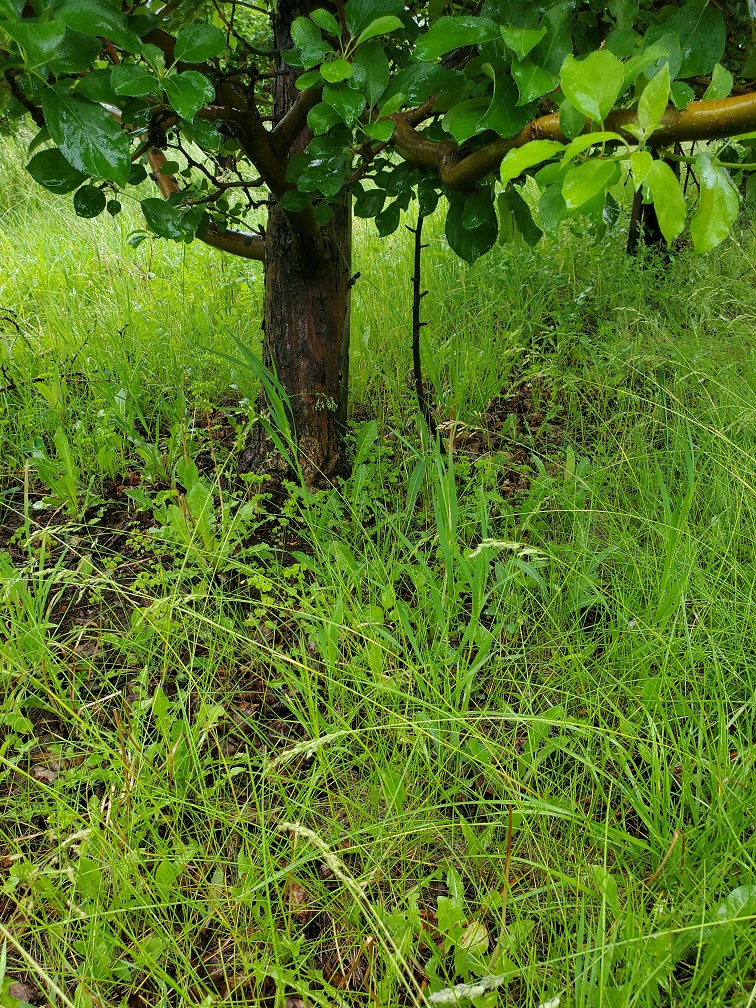An interview with consultant Chuck Schembre on ecological methods for managing orchard floors
Acres U.S.A.: Orchard floor management is such an important topic; how worried should growers be about competition from grasses?
Chuck Schembre: Grasses are extremely important in any orchard system. My approach is to promote as many grasses as possible and to allow them to run their full lifecycles when possible.
Grasses are one of the strongest soil restoration species on the planet. They’re the most diverse in terms of their ability to grow in all types of conditions and climates; they’re very resilient, and they are highly efficient at producing root exudates. They’re probably the greatest carbon pump we have on the planet and are great at building soil organic matter. It’s root exudation and that liquid carbon pump, or photosynthetic carbon pump, that’s building more than 50 percent of the soil organic matter production underground. That’s the biological hotspot — the rhizosphere — and grasses probably create the most rich and robust soil microbial life.
One of the key species that associates with grasses is mycorrhizal fungi. For all perennial crops to become a resilient system, they need an abundance of mycorrhizal fungi — both ecto- and endo-. I believe grasses are a paramount species to create strong soil health and a resilient system.
Acres U.S.A.: So, how can growers keep grasses in the orchard as much as possible? And what’s the difference between a newly planted and an established tree in terms of that management?
Schembre: In orcharding, in particular out West, there’s a lot of fear about competition of any plant species growing in the orchard. In California’s Central Valley you see these bare orchards — nothing growing in them. There is a lack of understanding that grasses or any plant growing around a tree is actually supporting the tree’s health.
But yes — when we’re establishing a new orchard or a vineyard, it is very important to keep a good amount of vegetation-free area. I hate using the word “weeds,” but it is important to establish a weed-free area around the vine or tree during the first two years. It’s only when the tree or vine becomes four to five years old that you can really allow grasses or other plant species to proliferate around the base of it. It’s hard to juggle, because when we keep the tree row or vine row free of weeds, we’re not actually following the principles of soil health, which is to keep a living root in the ground, keep the soil armored, etc. We’re forced to contradict the principles of soil health for a period of time. We’re disturbing the soil and keeping it free of vegetation — which is our microbial carbon pump.
So, it’s just finding a balance. My approach with growers as a consultant, and in my own farming, is during the major part of the growing season to try to keep as narrow a strip as possible in the tree or vine row. But once we go into the dormant season, allow as much vegetation as possible to repopulate into that tree or vine row.
When you’re not using conventional herbicides, especially pre-emergent, you can get a nice repopulation of the grasses, or whatever is in the latent seed bank, out in those fields. You can promote vegetative growth through the fall into the winter, trying to maximize ground cover and a living root. That is what I believe is the best approach. It doesn’t have to be all or nothing.
Acres U.S.A.: How do you reduce that vegetation in the spring to try to reestablish an area where the young tree isn’t competing?
Schembre: If you’re approaching it with conventional herbicides, you have a lot of flexibility in the timing of when you would spray. And there are a lot of conventional non-systemic contact herbicides out there that probably don’t have a huge impact on the soil microbial life, if you use a really reduced rate and time it just right.

But if you’re approaching it organically, which is primarily my background, the emphasis is on in-row cultivating and mowing equipment. There’s no silver bullet; there’s no perfect option. This is really one of the hardest management tasks in the orchard or vineyard. Everyone committed to soil health is scratching their head over it, especially when you’re first establishing a new orchard or vineyard, because some of this equipment is pretty aggressive and will disturb the new growing plant. A lot of orchards have a crew come in and actually hoe around the tree or vine, even at a fairly large scale. People will do that in an organic system. All organic approaches are relatively expensive and require more labor, until you can allow the entire orchard floor to become vegetated year-round.
Then there’s a variety of equipment out there, like the Clemens weed knife or weed hoe; it’s one of the oldest organic weed management orchard tools. It basically cuts underneath the vegetation. The timing has to be right because if there’s too much moisture, a lot of these plants just re-root themselves. You might have to run the Clemens two or three times. Most of this equipment has spring-loaded action, where the lever hits the trunk or rebar next to the plant and then slings around it.
Brands like Rinieri have a bunch of options with small mowers — they look like weed-eater mechanisms. Then there’s the Badger, which has tines that spin vertically like a power harrow. It aggressively stirs up the soil. The problem is that it also turns up weed seed. So it’s sometimes a bit of an insane process; you’re trying to manage weeds, but you’re stirring up more weed seed. I am not a fan of the Badger or of cultivation in the tree or vine row.
Acres U.S.A.: How deep are each of these tools going, in order to not disturb the tree roots?
Schembre: Generally, three to four inches. Some old-school organic weed managers use a small plow that heaps up soil next to the plant, cutting six to seven inches deep. Some growers actually think a little bit of root severing, especially to a vine, stimulates growth. But any soil disturbance around the vine or tree row is going to set you up for fighting a really hard battle with weeds.
The mowers, on the other hand, are probably one of the better tools we can use, but the plants have to be well-established. When we get to year five or so and the tree or vine is well-established, we can promote vegetation and just mow it. Some of the newer equipment allows you to begin mowing in year two next to the plant. There’s an Italian mower called the Nobili that mows in the middles and spits the cuttings of the cover crop as a mulch into the tree or vine row. That’s pretty cool, but you would have to already have the tree row weeds well managed.
And then, just to round it off, there are the organic herbicides. They are fairly effective, but they require more diligence in the timing. You can’t let most weeds get above six inches, and you have to get at them early and fairly often. The organic herbicides are more expensive than most of the conventional ones, but there are some new products starting to come out on the market that work really well. There’s Contact Organics, and then Harpe Bio, which are both relatively new bioherbicides about to hit the commercial market that have a lot of promise. They’ve put a lot of R&D into some alternative chemistries, and they’re supposed to be fairly effective, allowing the vegetation to fully decompose.

and provide natural fertilizer.
Weeds will grow back to some degree, but when you’re working with organic herbicides — and I do have a lot of experience with many organic herbicides — you have to have a different mindset around using them. If you want a very crisp, clean vine row or tree row, then you’re already missing the point. What we want to do is just keep things in check. We don’t want to let the vegetation completely out-compete the new plant that we put in the soil.
But the most important conversation to have around orchard and vineyard establishment — where most companies and growers really miss the boat — is building and promoting as strong of fungal soil as we can going into planting. We need to put trees and vines into the most healthy, fungally dominated soil we can. Most trees are being planted into what’s basically a construction site. It’s been completely deep-ripped, pulverized, cleaned, smoothed out. Then they plug it into soil that’s bacterially dominated — which brings annual weeds — a tree that actually developed on this planet to live in a fungally dominated soil.
I think we’ve got to start at the beginning and set up these systems for resiliency. And then, when we put the plant in the ground, we’re already able to better manage for soil health and non-chemical weed management. That would be the ultimate goal.
Acres U.S.A.: Can you give a rule-of-thumb generalization for how big that weed-free zone around a new tree needs to be — say for apples east of the Mississippi? Are we talking about a foot on either side?
Schembre: Yeah, I think about a foot on each side — a two-foot width. Or even narrower. If you can get it narrower, that would be ideal. And then you do have grasses just on the periphery, or other plants that can begin associating with the tree — the mycorrhizal fungi associations, all the benefits you’re getting from a living plant growing near the tree.
East of the Mississippi is a different monster in terms of managing tree rows and weeds because you’ve got moisture all year. Out West I do believe it’s a little easier. In some cases it’s a lot easier to manage an orchard organically in the tree row because there isn’t moisture during the summer. A lot of the orchards in the East deal with a lot of voles and field mice that girdle trees, and vegetation around the tree provides more habitat for them.
Now, let’s get to the root of the problem: most farms don’t have much ecological support. We need birds of prey, raptors, other things that may predate around the orchard. Sometimes the issues that we have with management — even weeds in the tree row — might be a bigger ecological issue that we have to be looking at as well.
Acres U.S.A.: Definitely. What about other plants around the trees — comfrey, wormwood, yarrow, etc.? Do any commercial growers do that, or is that just a homestead-scale solution?

Schembre: I haven’t met a large grower who has attempted that and succeeded other than by default — letting a lot of latent seed just populate. There’s an almond grower in California who promotes tremendous vegetation around the tree row; they have to terminate vegetation in the cover crop middle because that’s where they lay their nuts, but they’re maximizing vegetation in the tree row, and there’s a lot of different species coming up. It’s not this ideal medicinal mix of comfrey and yarrow, but there are a lot of different types of bunch grasses and forbs in the mix. Trees do thrive off of an association with other plants.
Trees also need a lot of different residues and organic matter and carbonaceous materials that are decomposing around the tree base. In a more homestead, permaculture, food forest approach, you really can farm fruit completely chemical and input free, when you get that diversity rocking and rolling. You might have to address some nutrient deficiencies, depending on your soil and climate. But yeah, there’s much more opportunity around that with the small homestead — say a one-acre orchard and below.
Acres U.S.A.: Same thing with putting down wood chips or biomass or whatever, I assume — not going to be possible on a commercial scale, but a good idea for a smaller producer?
Schembre: Yeah, it is. Most of the orchards that I step foot in that are big commercial orchards are just completely devoid of carbon material and organic matter around the tree row. It’s basically lifeless soil. It would be ideal to get some compost or wood chip or chunky composted material down under the tree row, but it’s a huge expense.
That’s why trying to get vegetation to populate around the tree is even more important. The next best thing is to use plants to pump carbon and add residues into the soil. That’s why we try to get as much vegetation around the tree as we can, when we can. Most orchards are very deficient in a diversity of fungal life, and that is the most important component of soil to build resiliency in the orchard.
I can’t stress that enough. There’s actually a connection between the health of the saprophytic fungi in the topsoil — what’s going on with decomposition around the tree — and in the phyllosphere and the canopy of the tree. There’s a connection between the health of the fungi in the topsoil and in the bark. A lot of these saprophytic fungi are the antagonists or the controllers of fungal pathogens.
So, when we think about managing for ground cover and promoting as much diversity and health as we can, there’s also an issue with fungicide input. Even if you’re implementing great principles of soil health, if you have a big fungicide program — which most orchards do — that is a huge disturbance to that soil fungi life. There’s a lot of money spent in what we call “sanitizing” the orchard — sweeping up fallen fruit or nuts around the tree because that’s where scab or fungal inoculants overwinter, or even larvae from certain insects — like in almonds, the navel orange worm. People spend a tremendous amount of money sweeping up dead, or what they call “mummy,” nuts. That’s another reason people want a clean tree row — they want to be able to come in with their equipment and clean up these nuts.

and good decaying residues around the tree base
When we have a more resilient, functioning ecosystem, or if we can integrate livestock, that changes the whole situation. If we can integrate livestock into an orchard, we can actually solve a lot of these problems. For instance, sheep will feed on the fallen nut and eat the larvae of the navel orange worm. Same thing with apples — sanitation is huge because of apple scab. People are applying 50 pounds per acre of urea in late fall so that they can decompose the material.
But if we are enhancing the saprophytic fungi, which are the major decomposers, and if we can get livestock into the orchard, their manure and urine and their gut biology enhances that decomposition of the leaf litter, and they’re going to eat the apples, which overwinter coddling moth. They’re a super strong tool.
Now, most orchardists can’t even consider livestock in the equation. But I think there’s an opportunity out there even for people who are not orchardists — who are shepherds — an opportunity to have a business around moving sheep, in particular, through orchards and helping these growers lower that cost of sanitation.
Acres U.S.A.: And in a highly ecological system that doesn’t have livestock, do you think it would still be able to deal with most of what falls by itself — without having to spend a ton of money picking stuff up or applying urea?
Schembre: I think so. Sometimes you meet growers who have really great ecological health in their orchards by default, and maybe they have a lot of wild turkeys that are coming in. Wildlife comes into a healthier farm environment. You can leverage mother nature. We always talk about mimicking nature’s design. Maybe we don’t have to obsess with bringing in livestock, but we can get some of nature’s critters to help out.














